|
9/11 Day Five
Cappadocia
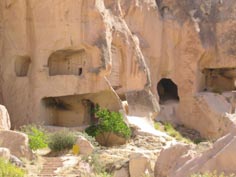 Stopped
for a photo op of Cappadocia’s odd rock formations with houses embedded
within. Staying at the incredible Museum Hotel where the owner, a collector,
has placed incredible handicrafts throughout the individualized designed
rooms; swimming pool, ping pong table, Internet computer, terraces to see
the lovely sunsets and sunrises. Stopped
for a photo op of Cappadocia’s odd rock formations with houses embedded
within. Staying at the incredible Museum Hotel where the owner, a collector,
has placed incredible handicrafts throughout the individualized designed
rooms; swimming pool, ping pong table, Internet computer, terraces to see
the lovely sunsets and sunrises.
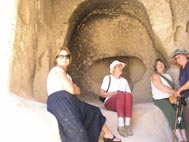 Some
took the hot air balloon ride early the second morning. Some
took the hot air balloon ride early the second morning.
Zelve is
UNESCO site - a city built into the rocks. It was evacuated when erosion
made it dangerous. Turks have summer homes and so don’t have time for
traveling. The French discovered Cappadocia in the 1960’s. Germans came too.
Rock formations caused by volcanoes (4,000 BC). The ash spread out and piled
up. People settled in the area. River provides clay for pottery. Easy to
carve and make space for animals and then decided to use it for granaries
and then as homes. Built fortresses for protection. Christians went
underground to avoid Romans (1,200 people for a month). Paintings in caves
which have been protected due to the lack of humidity.
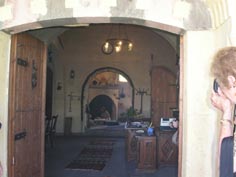 Passed
melons growing in dry earth. Crushed rocks were heaped around the roots to
provide better soil. We also saw women boiling grapes to make wine. When
people are self-sufficient they tend to be less insecure. There were outdoor
shops with items covered with material while the owner was away. No stealing
even though there were no doors or locks. Passed
melons growing in dry earth. Crushed rocks were heaped around the roots to
provide better soil. We also saw women boiling grapes to make wine. When
people are self-sufficient they tend to be less insecure. There were outdoor
shops with items covered with material while the owner was away. No stealing
even though there were no doors or locks.
Bought a
Turkmenistan wedding hat at the jingle jangle row of shops where we stopped.
Lots of Indian/Afghanistani clothing.
First
destination was the third valley which was occupied as recently as 1960.
They get 1 – 1.5 meters of snow in the winter. May brings torrential rain. Orchestras and ballets were held in ancient sites during the time of Ataturk.
Bulgar, cracked wheat, is the main food for Anatolia. Mill of carved stone
had sufficient space to accommodate the bellies of donkeys who walked round
and round making the grinding possible.
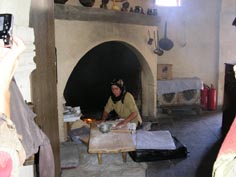 Geotecture not caves are man-made. We saw many dove coves (to pigeon hole
something comes from the holes in the rocks where the birds go). Some
pigeons can do somersaults for amusement (were bred from those who did it to
escape from eagles). Balikli Church early Christians picked up the fish as
a symbol for Christ around the 700s AD. Meli showed us how they came up with
the symbol as well as the double cross, which is found in many churches. Geotecture not caves are man-made. We saw many dove coves (to pigeon hole
something comes from the holes in the rocks where the birds go). Some
pigeons can do somersaults for amusement (were bred from those who did it to
escape from eagles). Balikli Church early Christians picked up the fish as
a symbol for Christ around the 700s AD. Meli showed us how they came up with
the symbol as well as the double cross, which is found in many churches.
1922
Turks were forced by the British to leave Thesalonika, Greece. Christian
Turks replaced Bosnian Muslims. Instanbul Orthodox church changed to compete
with Roman Catholic rituals. Monastery and mosque – different faiths lived
side-by-side until 1920.
Saw a
tree with white papers attached with people’s wishes. Turkic is a made up
word. Russia vs. British Empire divided Asia. Turkistan incorporated
different tribes; Altaic region. Russia took Turkistan and divided states
within Soviet Union. 1947 Russians banned Turkish language. People lost
Turkish identity with shamanistic rituals. God is beauty; a beautiful
something is given God attributes (votives in Mongolia; beautiful sites)
Goreme is
the second biggest city in Capadoccia; 25% of oil consumed from Turkey.
Solar heating is now required.
Lunch in
Nevsehir (new city). Manti (tiny dumplings stuffed with lamb in red sauce)
with yogurt and melted butter. Fresh mint and other spices. Preceded by
salad with oil and squeezed lemon.
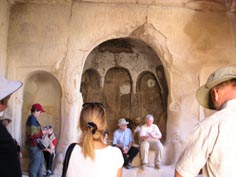 Underground city where Christians lived 1-4 weeks. All dark as there was
only one area allowed for fire and cooking. Z-zag air vents and multiple z-zag
entrance to disguise both. Church, birthing room, animal level. Stone was
soft to carve but hardened on exposure to air. Underground city where Christians lived 1-4 weeks. All dark as there was
only one area allowed for fire and cooking. Z-zag air vents and multiple z-zag
entrance to disguise both. Church, birthing room, animal level. Stone was
soft to carve but hardened on exposure to air.
Uchisar –
stopped to photograph women cleaning wool. One invited us into her adjoining
home. She welcomed all of us to sit and to see her dowry of embroidered
items. Her 8 year old son and little daughter entertained us. They had many
rooms, bathroom. We tasted homemade tomato sauce (salty) and fresh apricots.
“Oya” is the embroidered edge of a scarf. “Knitted the story like an oya.”
|
![]()
